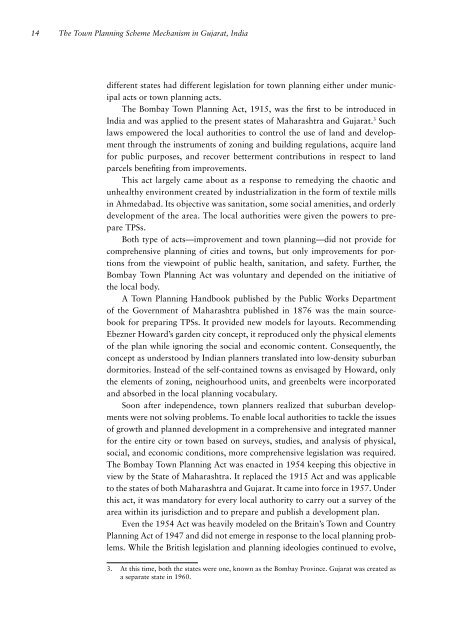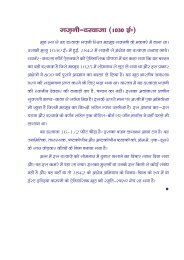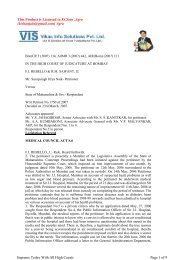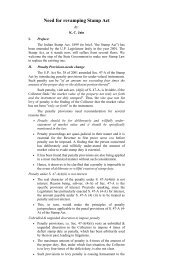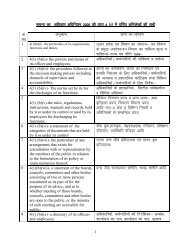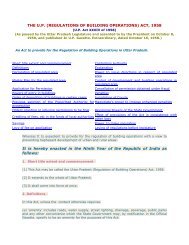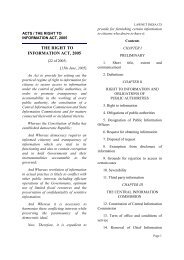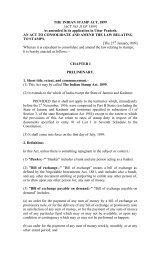The Town Planning Mechanism in Gujarat, India by ... - Agra Redco
The Town Planning Mechanism in Gujarat, India by ... - Agra Redco
The Town Planning Mechanism in Gujarat, India by ... - Agra Redco
- No tags were found...
Create successful ePaper yourself
Turn your PDF publications into a flip-book with our unique Google optimized e-Paper software.
14 <strong>The</strong> <strong>Town</strong> <strong>Plann<strong>in</strong>g</strong> Scheme <strong>Mechanism</strong> <strong>in</strong> <strong>Gujarat</strong>, <strong>India</strong>different states had different legislation for town plann<strong>in</strong>g either under municipalacts or town plann<strong>in</strong>g acts.<strong>The</strong> Bombay <strong>Town</strong> <strong>Plann<strong>in</strong>g</strong> Act, 1915, was the first to be <strong>in</strong>troduced <strong>in</strong><strong>India</strong> and was applied to the present states of Maharashtra and <strong>Gujarat</strong>. 3 Suchlaws empowered the local authorities to control the use of land and developmentthrough the <strong>in</strong>struments of zon<strong>in</strong>g and build<strong>in</strong>g regulations, acquire landfor public purposes, and recover betterment contributions <strong>in</strong> respect to landparcels benefit<strong>in</strong>g from improvements.This act largely came about as a response to remedy<strong>in</strong>g the chaotic andunhealthy environment created <strong>by</strong> <strong>in</strong>dustrialization <strong>in</strong> the form of textile mills<strong>in</strong> Ahmedabad. Its objective was sanitation, some social amenities, and orderlydevelopment of the area. <strong>The</strong> local authorities were given the powers to prepareTPSs.Both type of acts—improvement and town plann<strong>in</strong>g—did not provide forcomprehensive plann<strong>in</strong>g of cities and towns, but only improvements for portionsfrom the viewpo<strong>in</strong>t of public health, sanitation, and safety. Further, theBombay <strong>Town</strong> <strong>Plann<strong>in</strong>g</strong> Act was voluntary and depended on the <strong>in</strong>itiative ofthe local body.A <strong>Town</strong> <strong>Plann<strong>in</strong>g</strong> Handbook published <strong>by</strong> the Public Works Departmentof the Government of Maharashtra published <strong>in</strong> 1876 was the ma<strong>in</strong> sourcebookfor prepar<strong>in</strong>g TPSs. It provided new models for layouts. Recommend<strong>in</strong>gEbezner Howard’s garden city concept, it reproduced only the physical elementsof the plan while ignor<strong>in</strong>g the social and economic content. Consequently, theconcept as understood <strong>by</strong> <strong>India</strong>n planners translated <strong>in</strong>to low-density suburbandormitories. Instead of the self-conta<strong>in</strong>ed towns as envisaged <strong>by</strong> Howard, onlythe elements of zon<strong>in</strong>g, neighourhood units, and greenbelts were <strong>in</strong>corporatedand absorbed <strong>in</strong> the local plann<strong>in</strong>g vocabulary.Soon after <strong>in</strong>dependence, town planners realized that suburban developmentswere not solv<strong>in</strong>g problems. To enable local authorities to tackle the issuesof growth and planned development <strong>in</strong> a comprehensive and <strong>in</strong>tegrated mannerfor the entire city or town based on surveys, studies, and analysis of physical,social, and economic conditions, more comprehensive legislation was required.<strong>The</strong> Bombay <strong>Town</strong> <strong>Plann<strong>in</strong>g</strong> Act was enacted <strong>in</strong> 1954 keep<strong>in</strong>g this objective <strong>in</strong>view <strong>by</strong> the State of Maharashtra. It replaced the 1915 Act and was applicableto the states of both Maharashtra and <strong>Gujarat</strong>. It came <strong>in</strong>to force <strong>in</strong> 1957. Underthis act, it was mandatory for every local authority to carry out a survey of thearea with<strong>in</strong> its jurisdiction and to prepare and publish a development plan.Even the 1954 Act was heavily modeled on the Brita<strong>in</strong>’s <strong>Town</strong> and Country<strong>Plann<strong>in</strong>g</strong> Act of 1947 and did not emerge <strong>in</strong> response to the local plann<strong>in</strong>g problems.While the British legislation and plann<strong>in</strong>g ideologies cont<strong>in</strong>ued to evolve,3. At this time, both the states were one, known as the Bombay Prov<strong>in</strong>ce. <strong>Gujarat</strong> was created asa separate state <strong>in</strong> 1960.


